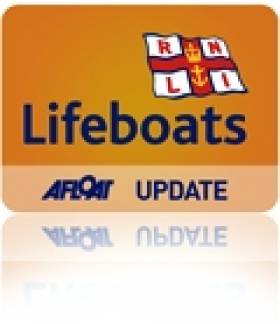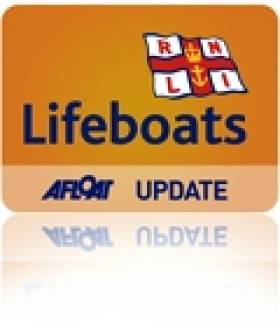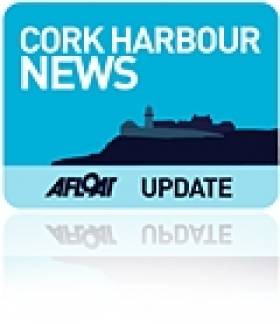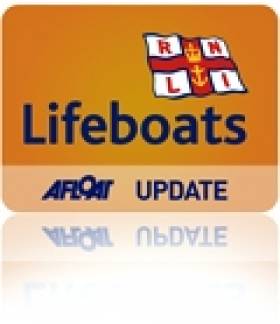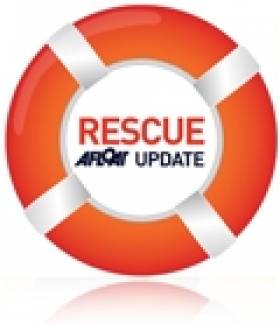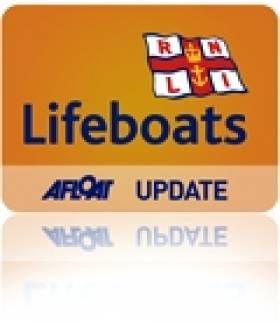Displaying items by tag: RNLI
#lifeboat – At 1.20pm, Thursday afternoon, June 11, Valentia Coast Guard requested Lough Derg RNLI Lifeboat to launch to assist five people on board a 49ft (15m) yacht reported aground by Castletown Harbour on the County Clare shore.
The lifeboat launched at 1.30pm with helm Eleanor Hooker, Keith Brennan and Lorna Walsh on board. Winds were northeasterly, Force 2/3, visibility was very good.
After a thorough search, the lifeboat informed Valentia Coast Guard they did not locate a vessel matching the description given, in either Castletown Harbour or Dromane Harbour, close by. The lifeboat was requested to travel south and check another location at Church Bay, on the Clare shore. The lifeboat located the cruiser at Parkers Point, on the Tipperary Shore, it had suffered engine failure, the water depth at their location was 14.9ft.
All five people were safe and unharmed, they were requested to put on their lifejackets. An RNLI volunteer was transferred across to the casualty vessel, where he reassured everyone. He established that in addition to engine failure, the boat had no steering.
The cruiser was taken under tow to the closest harbour, Garrykennedy, where it was safely tied alongside.
Deputy Launching Authority, Peter Kennedy praised the lifeboat volunteers saying, 'the dealt with the challenge very efficiently, considering the size of the boat, and given its total loss of power and steering'.
The Lifeboat returned to station and was ready for service again at 3.20pm.
Union Hall RNLI Have Two Call Outs in 24 Hours
#rnli – Lifeboat crew with Union Hall RNLI had their second callout in 24 hours this morning when a member of the public became concerned for the safety of a paddle boarder who had disappeared from view.
The lifeboat was launched at 9.10am following a call from Valentia Coast Guard after a member of the public reported that they had lost sight of a paddle boarder between Rabbit Island and Myross Island.
In calm conditions with a north easterly force four wind the lifeboat searched the area for the missing paddle boarder but was stood down a short time later as it is believed the person made it safely ashore unaided.
Commenting on the callout John Kelleher Union Hall RNLI Lifeboat Operations Manager said, 'It has been a busy 24 hours for our volunteer lifeboat crew. Even though this turned out to be a false alarm with good intent I would commend the member of the public for contacting the emergency services. You never know when that call could save a life and that is what we are here to do.'
The callout follows on from yesterday when Union Hall RNLI rescued two men after their 18ft pleasure boat got into difficulty off the coast of West Cork. The volunteer crew was alerted shortly after 1.30pm following a report that a pleasure boat was experiencing engine problems south of Castletownshend Harbour.
#RNLI - Union Hall RNLI rescued two men this afternoon (Monday 8 June) after their 18-foot pleasure boat got into difficulty off the coast of West Cork.
The volunteer crew was alerted shortly after 1.30pm by the Irish Coast Guard following a report that a pleasure boat was experiencing engine problems south of Castletownshend Harbour.
Within five minutes the inshore lifeboat, helmed by Chris Collins and with Anthony Walsh and Stephen Hurley onboard, was launched and made its way to the scene.
Weather conditions at the time were described as good with a Force 2-3 wind blowing and a moderate sea.
The lifeboat crew located the vessel a short time later at 1.56pm and observed that the two crew members onboard were in no immediate danger.
Union Hall RNLI proceeded to establish a tow line and bring the two men and their boat safely to Union Hall.
Speaking following the callout, John Kelleher, lifeboat operations manager at the station that's been operational since last September, said: "The crew onboard the pleasure boat did the right thing this afternoon by alerting the emergency services once they found themselves in difficulty.
"Our volunteers, who responded quickly, were delighted to be able to assist and we are pleased that everyone has now been returned safe and well to Union Hall."
A new exhibition on the role of the Royal National lifeboat Institution is coming to Cork Harbour's Camden Fort Meagher In Crosshaven and will be open to the public every weekend during this coming month of July.
The bravery of RNLI volunteers who risked their lives to save others during the First World War are the focus of an exhibition touring the UK and Ireland, Hope in the Great War.
The exhibition features six inspirational lifeboat rescue stories from around our coasts during the war. During the Great War, lifeboat crews launched 1,808 times, rescuing 5,332 people. And it was often down to the older generation to go to the aid of those in danger at sea, while many of the younger men were on active duty.
Among the stories featured in the exhibition are Cromer RNLI lifeboat's rescue of the Pyrin and Fernebo, which saw 33 people saved from the sea on 9 January 1917, and the 1914 Whitby RNLI lifeboat rescue of the wrecked hospital ship HMHS Rohilla which saw 144 people saved from the sea.
It is touring for four years – the length of the war – and opened on 4 February 2014 in the RNLI's Henry Blogg Museum in Cromer.
The exhibition was made possible by an Arts Council England grant of £78,200 awarded to the RNLI in order to share more widely the role of the charity's coastal community volunteers during WW1 to help mark the centenary. Community groups have come together to create interactive artworks to help tell the stories of the RNLI during the Great War.
Jacqui Palmer who is co-ordinating the exhibition, says: "As the world remembers the tragic events of the Great War, it's important that we also remember the courage and determination of those who risked their own lives to save others at a sea.
More than 15,000 people have visited the exhibition so far and community groups have been creating amazing artworks for the exhibition, so it's been a great way for everyone to come together and learn about the courageous work of our RNLI volunteers and coastal communities during the conflict."
Bangor RNLI Celebrates 50 Years Of Lifesaving
#RNLI - On Friday 5 June, Bangor RNLI’s volunteer lifeboat crew, fundraisers and supporters gathered at the Marine Court Hotel to celebrate 50 years of saving lives at sea.
Records held in the archives of Bangor lifeboat station indicate that a lifeboat in Belfast Lough was first established at Groomsport in 1858, following the wrecking of a vessel near Bangor, with the loss of all the crew and in full view of local people standing on the shore.
Groomsport lifeboats launched 55 times and saved 87 lives over a period of 62 years from 1858 to 1920, when the station was closed.
It was reported that the number of lifeboat services were not more numerous due to the great number of fisherman and pilots in the area "of a fine and hardy type, who are not slow to risk their lives in their own boats, in which they have great confidence."
Some 45 years after the closure of Groomsport Lifeboat Station, an ever-increasing demand for lifesaving services along the coast led to considerations of re-establishing a lifeboat service in the Belfast Lough area.
Under the guidance of Ernie Hay, the first honorary secretary and North Down Borough Council officer, the RNLI chose to place a D-Class inflatable lifeboat at Bangor Harbour, opening for business on 15 May 1965.
With the co-operation of North Down Borough Council, the lifeboat was stored in the Tower House yard and was launched on a trolley at the slipway beside the old Harbour Masters Office. The co-operation between North Down Borough Council and the RNLI has continued without a break since those times.
The service of the lifeboat continued under the care of local volunteers and the demands put upon her volunteer crew increased year on year. Successive honorary secretaries managed the operational demands and the branch fundraising committee and ladies’ guild worked hard behind the scenes, raising the funds to cover operational costs. Over 40 local businesses also contributed to the funds by maintaining collecting boxes on their premises.
In 1984, following the construction of the Eisenhower Pier, North Down Borough Council built a new boathouse and slipway, which allowed for the subsequent upgrading of the boat to an Atlantic 21 class lifeboat, the then ‘Rolls Royce’ of fast inshore lifeboats.
The Youth of Ulster, a new boat funded by local donations, was put on station in 1990 and was formally named by HRH Prince Edward, Earl of Wessex in 1991.
In 2002 the RNLI invested £250,000 in building a new boathouse and crew facilities on a site kindly granted by North Down Borough Council. This boathouse was designed to accommodate the latest class of fast response inshore lifeboat.
Bangor RNLI celebrated its 40th anniversary in 2005 and, as a reflection of its fine service record since its foundation, in 2006 Bangor took delivery of the first Atlantic 85 class lifeboat in Ireland, the Jessie Hillyard. The new class of fast response inshore lifeboat costing over £120,000 was made possible through a legacy from Eileen Freeman in memory of her late mother Jessie Hillyard.
That same year, Bangor RNLI was the busiest lifeboat station out of all the 43 stations in Ireland, launching 53 times. From 2007 RNLI Bangor Lifeboat has been the busiest lifeboat out of the eight coastal stations in Northern Ireland.
Since the foundation of the station 50 years ago, over 110 local people have served as crew members. To date, over the years, Bangor lifeboats have launched 1,252 times, rescued over 1,000 people and saved 191 lives.
Everyone connected with Bangor RNLI – the crew, station management, fundraisers and helpers – are all volunteers, giving freely of their time, braving all weathers, 24 hours a day, 365 days a year to help save life at sea.
Currently there are 20 crew members, male and female, from all walks of life including, among others, a council officer, a restaurateur, a plumber, a solicitor, a care worker, a satellite television engineer, a lorry driver and an orthopaedic surgeon.
RNLI volunteers continue to support annual seafront events, raise funds for other RNLI lifeboats and local organisations and, for 50 years, have played a vital part in Bangor’s maritime and community affairs.
#RNLI - Wicklow RNLI assisted two fishermen on a six-metre fishing boat in difficulties off Kiloughter beach on Friday morning (5 June).
The lifeboat, with three volunteer crew, launched at 8.55am following a report that the boat had a rope caught in its propeller.
After locating the fishing vessel drifting four miles north of Wicklow Harbour, they managed to free the rope from the propeller allowing the fishermen to get underway and resume fishing.
The lifeboat crew returned to station once the Irish Coast Guard was satisfied the fishing vessel required no further assistance.
The crew on this callout were helm Graham Fitzgerald, Alan Goucher and Terry Sillery.
Lifeboat Launches to Yacht Aground on Lough Derg
#rnli – Lough Derg RNLI Lifeboat launched to assist two people on board a 26ft–yacht, aground east of Mountshannon Harbour last night.
At 7.57pm on Friday evening, June 6, Valentia Coast Guard requested Lough Derg RNLI Lifeboat to launch to assist two people on board a 23ft yacht, aground east of Mountshannon Harbour.
The lifeboat launched at 8.08pm with helm Eleanor Hooker, Ger Egan and Dean O'Sullivan on board. Winds were south westerly, Force 6, gusting 7, visibility was good.
The lifeboat located the cruiser at 8.27pm. The two people were safe and unharmed and wearing their lifejackets. Killaloe Coast Guard were on scene and had arranged for their D-class lifeboat to take the yacht off the rocks. Valentia Coast Guard requested Lough Derg Lifeboat to remain on standby on scene, until the vessel was off the rocks and safely tied alongside at Mountshannon.
Deputy Launching Authority, Pat Garland, advises all boat users to note that 'water levels on the lake are particularly low at the moment and to bear this in mind when passage planning'.
The Lifeboat returned to station and was ready for service again at 10.50pm.
#lifeboat – A brave Dun Laoghaire inshore lifeboat trio have been honoured with an RNLI award for a difficult rescue off Sandymount last year. Helmsman Rory Bolton along with Dan O'Sullivan and Damien Payne have received 'special recognition' and a framed Letter of Thanks.
As Afloat.ie reported at the time, the trio rescued a kitesurfer in hazardous weather off Sandymount when the person was unable to get ashore in dangerous surf conditions.
The D-Class Inshore lifeboat launched from the ILB Boathouse at Dun Laoghaire's East Pier on the morning of New Year's Day as winds gusted to Gale Force 8.
After assessing conditions on Dublin Bay, the lifeboat proceeded towards the Booterstown end of Sandymount Strand where the Dun Laoghaire Coast Guard Unit could see the casualty in the breaking surf. The kitesurfer was taken on board the lifeboat and reunited with his family back at the lifeboat station. Medical attention was not needed.
The Director of Operations for the RNLI George Rawlinson noted that the "poor visibility, gale force winds and rough seas of up to four metres" were particularly challenging.
Recovery of the casualty from the breaking surf required the best standards of helmsmanship by Rory Bolton. Excellent seamanship ensured a safe and effective operation at the limits of the ILB's capabilities.
The award was presented to Rory Bolton who accepted it on behalf of the crew by Owen Medland, Divisional Operations Manager at the lifeboat station in Dun Laoghaire.
The D-Class Inshore lifeboat (ILB) is a fast, fully-inflatable boat equipped with VHF Radio and electronic navigation as well as First Aid equipment. The D-Class at Dun Laoghaire performs around half of the station's annual call-outs. In 2014, Dun Laoghaire RNLI launched 56 times and brought 55 people to safety.
CH Marine Stage 'Lifejacket Awareness Week'
#lifejacketawareness – Inflatable Lifejackets are without doubt the most convenient and unobtrusive PFDs available but they do need regular checks and servicing for their safe operation when needs. Leading Lifejacket supplier CH Marine is holding a Life Jacket Awareness Week this week and offering information and guidance on the safe use and care of Gas Inflation Lifejackets. The RNLI are attending and, as well as daily tips ,special offers there are also chances to win some great lifejackets. Check out CH Marine Facebook Page for more.
#dinghycapsize – Volunteer lifeboat crew with Kilkeel RNLI launched yesterday evening at 6.30pm following reports of two people in the water off Killowen Point on Carlingford Lough. It is understood a member of the public raised the alarm on seeing two people in the water after their dinghies capsized.
Conditions at the time were choppy with a force four north westerly wind and good visibility. On arriving at the scene the lifeboat crew recovered the two exhausted casualties onto the lifeboat and took the two dinghies, which were drifting, under tow. The two were very cold but conscious. The lifeboat crew returned to Killowen Yacht club and was met by members of the South Down coastguard team and awaiting ambulance.
Commenting on the rescue John Fisher, Kilkeel RNLI said; 'This was a challenging callout for the lifeboat crew. The capsize happened near a sandbank and the lifeboat helm had to manoeuvre the lifeboat very carefully to safely recover the two people. The casualties were exhausted and very cold and our crew gave them warm blankets before returning them to shore.'



























